Guild
A guild /ɡɪld/ is an association of artisans or merchants who oversee the practice of their craft/trade in a particular area. The earliest types of guild formed as confraternities of tradesmen, normally operating in a single city and covering a single trade. They were organized in a manner something between a professional association, a trade union, a cartel, and a secret society. They sometimes depended on grants of letters patent from a monarch or other ruler to enforce the flow of trade to their self-employed members, and to retain ownership of tools and the supply of materials, but were generally regulated by the city government. A lasting legacy of traditional guilds are the guildhalls constructed and used as guild meeting-places. Guild members found guilty of cheating on the public would be fined or banned from the guild.
_van_het_Amsterdamse_lakenbereidersgilde_-_Google_Art_Project.jpg)
Typically the key "privilege" was that only guild members were allowed to sell their goods or practice their skill within the city. There might be controls on minimum or maximum prices, hours of trading, numbers of apprentices, and many other things. As well as reducing free competition, but sometimes maintaining a good quality of work, often these rules made it difficult or impossible for women, immigrants to the city, and non-Christians to run businesses working in the trade.
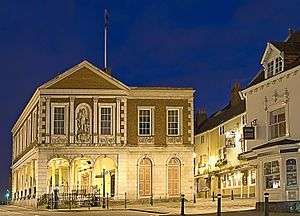
An important result of the guild framework was the emergence of universities at Bologna (established in 1088), Oxford (at least since 1096) and Paris (c. 1150); they originated as guilds of students (as at Bologna) or of masters (as at Paris).[1]
History of guilds
Early guild-like associations
A type of guild was known in Roman times. Known as collegium, collegia or corpus, these were organised groups of merchants who specialised in a particular craft and whose membership of the group was voluntary. One such example is the corpus naviculariorum, the college of long-distance shippers based at Rome's La Ostia port. The Roman guilds failed to survive the collapse of the Roman Empire.[2]
In medieval cities, craftsmen tended to form associations based on their trades, confraternities of textile workers, masons, carpenters, carvers, glass workers, each of whom controlled secrets of traditionally imparted technology, the "arts" or "mysteries" of their crafts. Usually the founders were free independent master craftsmen who hired apprentices.[3]
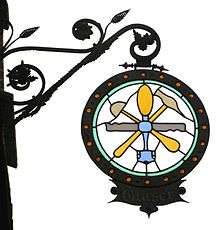
Post-classical guild
There were several types of guilds, including the two main categories of merchant guilds and craft guilds[4] but also the frith guild and religious guild.[5] Guilds arose beginning in the High Middle Ages as craftsmen united to protect their common interests. In the German city of Augsburg craft guilds are mentioned in the Towncharter of 1156.[6]
The continental system of guilds and merchants arrived in England after the Norman Conquest, with incorporated societies of merchants in each town or city holding exclusive rights of doing business there. In many cases they became the governing body of a town. For example, London's Guildhall became the seat of the Court of Common Council of the City of London Corporation, the world's oldest continuously elected local government,[7] whose members to this day must be Freemen of the City.[8] The Freedom of the City, effective from the Middle Ages until 1835, gave the right to trade, and was only bestowed upon members of a Guild or Livery.[9]
Early egalitarian communities called "guilds"[10] were denounced by Catholic clergy for their "conjurations" — the binding oaths sworn among the members to support one another in adversity, kill specific enemies, and back one another in feuds or in business ventures. The occasion for these oaths were drunken banquets held on December 26, the pagan feast of Jul (Yule)—in 858, West Francian Bishop Hincmar sought vainly to Christianise the guilds.[11]
In the Early Middle Ages, most of the Roman craft organisations, originally formed as religious confraternities, had disappeared, with the apparent exceptions of stonecutters and perhaps glassmakers, mostly the people that had local skills. Gregory of Tours tells a miraculous tale of a builder whose art and techniques suddenly left him, but were restored by an apparition of the Virgin Mary in a dream. Michel Rouche[12] remarks that the story speaks for the importance of practically transmitted journeymanship.
In France, guilds were called corps de métiers. According to Viktor Ivanovich Rutenburg, "Within the guild itself there was very little division of labour, which tended to operate rather between the guilds. Thus, according to Étienne Boileau's Book of Handicrafts, by the mid-13th century there were no less than 100 guilds in Paris, a figure which by the 14th century had risen to 350."[13] There were different guilds of metal-workers: the farriers, knife-makers, locksmiths, chain-forgers, nail-makers, often formed separate and distinct corporations; the armourers were divided into helmet-makers, escutcheon-makers, harness-makers, harness-polishers, etc.[14] In Catalan towns, specially at Barcelona, guilds or gremis were a basic agent in the society: a shoemakers' guild is recorded in 1208.[15]
In England, specifically in the City of London Corporation, more than 110 guilds,[16] referred to as livery companies, survive today,[17] with the oldest more than a thousand years old. Other groups, such as the Worshipful Company of Tax Advisers, have been formed far more recently. Membership in a livery company is expected for individuals participating in the governance of The City, as the Lord Mayor and the Remembrancer.
The guild system reached a mature state in Germany circa 1300 and held on in German cities into the 19th century, with some special privileges for certain occupations remaining today. In the 15th century, Hamburg had 100 guilds, Cologne 80, and Lübeck 70.[18] The latest guilds to develop in Western Europe were the gremios of Spain: e.g., Valencia (1332) or Toledo (1426).
Not all city economies were controlled by guilds; some cities were "free." Where guilds were in control, they shaped labor, production and trade; they had strong controls over instructional capital, and the modern concepts of a lifetime progression of apprentice to craftsman, and then from journeyman eventually to widely recognized master and grandmaster began to emerge. In order to become a master, a journeyman would have to go on a three-year voyage called journeyman years. The practice of the journeyman years still exists in Germany and France.
As production became more specialized, trade guilds were divided and subdivided, eliciting the squabbles over jurisdiction that produced the paperwork by which economic historians trace their development: The metalworking guilds of Nuremberg were divided among dozens of independent trades in the boom economy of the 13th century, and there were 101 trades in Paris by 1260.[19] In Ghent, as in Florence, the woolen textile industry developed as a congeries of specialized guilds. The appearance of the European guilds was tied to the emergent money economy, and to urbanization. Before this time it was not possible to run a money-driven organization, as commodity money was the normal way of doing business.
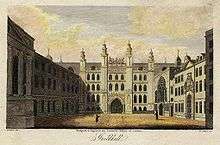
The guild was at the center of European handicraft organization into the 16th century. In France, a resurgence of the guilds in the second half of the 17th century is symptomatic of Louis XIV and Jean Baptiste Colbert's administration's concerns to impose unity, control production, and reap the benefits of transparent structure in the shape of efficient taxation.[20]
The guilds were identified with organizations enjoying certain privileges (letters patent), usually issued by the king or state and overseen by local town business authorities (some kind of chamber of commerce). These were the predecessors of the modern patent and trademark system. The guilds also maintained funds in order to support infirm or elderly members, as well as widows and orphans of guild members, funeral benefits, and a 'tramping' allowance for those needing to travel to find work. As the guild system of the City of London declined during the 17th century, the Livery Companies transformed into mutual assistance fraternities along such lines.
European guilds imposed long standardized periods of apprenticeship, and made it difficult for those lacking the capital to set up for themselves or without the approval of their peers to gain access to materials or knowledge, or to sell into certain markets, an area that equally dominated the guilds' concerns. These are defining characteristics of mercantilism in economics, which dominated most European thinking about political economy until the rise of classical economics.
The guild system survived the emergence of early capitalists, which began to divide guild members into "haves" and dependent "have-nots". The civil struggles that characterize the 14th-century towns and cities were struggles in part between the greater guilds and the lesser artisanal guilds, which depended on piecework. "In Florence, they were openly distinguished: the Arti maggiori and the Arti minori—already there was a popolo grasso and a popolo magro".[21] Fiercer struggles were those between essentially conservative guilds and the merchant class, which increasingly came to control the means of production and the capital that could be ventured in expansive schemes, often under the rules of guilds of their own. German social historians trace the Zunftrevolution, the urban revolution of guildmembers against a controlling urban patriciate, sometimes reading into them, however, perceived foretastes of the class struggles of the 19th century.
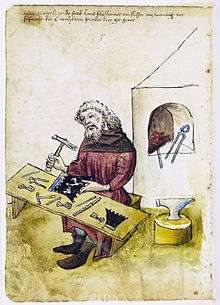
In the countryside, where guild rules did not operate, there was freedom for the entrepreneur with capital to organize cottage industry, a network of cottagers who spun and wove in their own premises on his account, provided with their raw materials, perhaps even their looms, by the capitalist who took a share of the profits. Such a dispersed system could not so easily be controlled where there was a vigorous local market for the raw materials: wool was easily available in sheep-rearing regions, whereas silk was not.
Organization
In Florence, Italy, there were seven to twelve "greater guilds" and fourteen "lesser guilds" the most important of the greater guilds was that for judges and notaries, who handled the legal business of all the other guilds and often served as an arbitrator of disputes. Other greater guilds include the wool, silk, and the money changers' guilds. They prided themselves on a reputation for very high-quality work, which was rewarded with premium prices. The guilds fined members who deviated from standards. Other greater guilds included those of doctors, druggists, and furriers. Among the lesser guilds, were those for bakers, saddle makers, ironworkers and other artisans. They had a sizable membership, but lacked the political and social standing necessary to influence city affairs.[22]
The guild was made up by experienced and confirmed experts in their field of handicraft. They were called master craftsmen. Before a new employee could rise to the level of mastery, he had to go through a schooling period during which he was first called an apprentice. After this period he could rise to the level of journeyman. Apprentices would typically not learn more than the most basic techniques until they were trusted by their peers to keep the guild's or company's secrets.
Like journey, the distance that could be travelled in a day, the title 'journeyman' derives from the French words for 'day' (jour and journée) from which came the middle English word journei. Journeymen were able to work for other masters, unlike apprentices, and generally paid by the day and were thus day labourers. After being employed by a master for several years, and after producing a qualifying piece of work, the apprentice was granted the rank of journeyman and was given documents (letters or certificates from his master and/or the guild itself) which certified him as a journeyman and entitled him to travel to other towns and countries to learn the art from other masters. These journeys could span large parts of Europe and were an unofficial way of communicating new methods and techniques, though by no means all journeymen made such travels — they were most common in Germany and Italy, and in other countries journeymen from small cities would often visit the capital.[23]
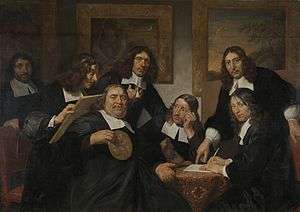
After this journey and several years of experience, a journeyman could be received as master craftsman, though in some guilds this step could be made straight from apprentice. This would typically require the approval of all masters of a guild, a donation of money and other goods (often omitted for sons of existing members), and the production of a so-called "masterpiece,' which would illustrate the abilities of the aspiring master craftsman; this was often retained by the guild.[24]
The medieval guild was established by charters or letters patent or similar authority by the city or the ruler and normally held a monopoly on trade in its craft within the city in which it operated: handicraft workers were forbidden by law to run any business if they were not members of a guild, and only masters were allowed to be members of a guild. Before these privileges were legislated, these groups of handicraft workers were simply called 'handicraft associations'.
The town authorities might be represented in the guild meetings and thus had a means of controlling the handicraft activities. This was important since towns very often depended on a good reputation for export of a narrow range of products, on which not only the guild's, but the town's, reputation depended. Controls on the association of physical locations to well-known exported products, e.g. wine from the Champagne and Bordeaux regions of France, tin-glazed earthenwares from certain cities in Holland, lace from Chantilly, etc., helped to establish a town's place in global commerce — this led to modern trademarks.
In many German and Italian cities, the more powerful guilds often had considerable political influence, and sometimes attempted to control the city authorities. In the 14th century, this led to numerous bloody uprisings, during which the guilds dissolved town councils and detained patricians in an attempt to increase their influence. In fourteenth-century north-east Germany, people of Wendish, i.e. Slavic, origin were not allowed to join some guilds.[25] According to Wilhelm Raabe, "down into the eighteenth century no German guild accepted a Wend."[26]
Fall of the guilds
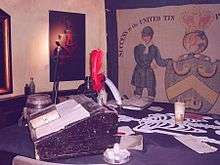
Ogilvie (2004) argues that guilds negatively affected quality, skills, and innovation. Through what economists now call "rent-seeking" they imposed deadweight losses on the economy. Ogilvie argues they generated limited positive externalities and notes that industry began to flourish only after the guilds faded away. Guilds persisted over the centuries because they redistributed resources to politically powerful merchants. On the other hand, Ogilvie agrees, guilds created "social capital" of shared norms, common information, mutual sanctions, and collective political action. This social capital benefited guild members, even as it arguably hurt outsiders.[27]
The guild system became a target of much criticism towards the end of the 18th century and the beginning of the 19th century. Critics argued that they hindered free trade and technological innovation, technology transfer and business development. According to several accounts of this time, guilds became increasingly involved in simple territorial struggles against each other and against free practitioners of their arts.
Two of the most outspoken critics of the guild system were Jean-Jacques Rousseau and Adam Smith, and all over Europe a tendency to oppose government control over trades in favour of laissez-faire free market systems grew rapidly and made its way into the political and legal systems. Many people who participated in the French Revolution saw guilds as a last remnant of feudalism. The Le Chapelier Law of 1791 abolished the guilds in France.[28] Smith wrote in The Wealth of Nations (Book I, Chapter X, paragraph 72):
It is to prevent this reduction of price, and consequently of wages and profit, by restraining that free competition which would most certainly occasion it, that all corporations, and the greater part of corporation laws, have been established. (...) and when any particular class of artificers or traders thought proper to act as a corporation without a charter, such adulterine guilds, as they were called, were not always disfranchised upon that account, but obliged to fine annually to the king for permission to exercise their usurped privileges.
Karl Marx in his Communist Manifesto also criticized the guild system for its rigid gradation of social rank and the relation of oppressor/oppressed entailed by this system. It was the 18th and 19th centuries that saw the beginning of the low regard in which some people hold the guilds to this day. In part due to their own inability to control unruly corporate behavior, the tide of public opinion turned against the guilds.
Because of industrialization and modernization of the trade and industry, and the rise of powerful nation-states that could directly issue patent and copyright protections — often revealing the trade secrets — the guilds' power faded. After the French Revolution they gradually fell in most European nations over the course of the 19th century, as the guild system was disbanded and replaced by laws that promoted free trade. As a consequence of the decline of guilds, many former handicraft workers were forced to seek employment in the emerging manufacturing industries, using not closely guarded techniques formerly protected by guilds, but rather the standardized methods controlled by corporations. Interest in the medieval guild system was revived during the late 19th century, among far right circles. Fascism in Italy (among other countries) implemented corporatism, operating at the national rather than city level, to try to imitate the corporatism of the Middle Ages.
Influence of guilds
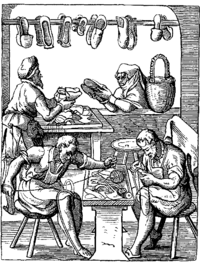
Guilds are sometimes said to be the precursors of modern trade unions. Guilds, however, can also be seen as a set of self-employed skilled craftsmen with ownership and control over the materials and tools they needed to produce their goods. Some argue that guilds operated more like cartels than they were like trade unions (Olson 1982). However, the journeymen organizations, which were at the time illegal,[29] may have been influential.
The exclusive privilege of a guild to produce certain goods or provide certain services was similar in spirit and character with the original patent systems that surfaced in England in 1624. These systems played a role in ending the guilds' dominance, as trade secret methods were superseded by modern firms directly revealing their techniques, and counting on the state to enforce their legal monopoly.
Some guild traditions still remain in a few handicrafts, in Europe especially among shoemakers and barbers. Some ritual traditions of the guilds were preserved in order organisations such as the Freemasons, allegedly deriving from the Masons Guild, and the Oddfellows, allegedly derived from various smaller guilds. These are, however, not very important economically except as reminders of the responsibilities of some trades toward the public.
Modern antitrust law could be said to derive in some ways from the original statutes by which the guilds were abolished in Europe.
Economic consequences
The economic consequences of guilds have led to heated debates among economic historians. On the one side, scholars say that since merchant guilds persisted over long periods they must have been efficient institutions (since inefficient institutions die out). Others say they persisted not because they benefited the entire economy but because they benefited the owners, who used political power to protect them. Ogilvie (2011) says they regulated trade for their own benefit, were monopolies, distorted markets, fixed prices, and restricted entrance into the guild.[23] Ogilvie (2008) argues that their long apprenticeships were unnecessary to acquire skills, and their conservatism reduced the rate of innovation and made the society poorer. She says their main goal was rent seeking, that is, to shift money to the membership at the expense of the entire economy.[30]
Epstein and Prak's book (2008) rejects Ogilvie's conclusions.[31] Specifically, Epstein argues that guilds were cost-sharing rather than rent-seeking institutions. They located and matched masters and likely apprentices through monitored learning. Whereas the acquisition of craft skills required experience-based learning, he argues that this process necessitated many years in apprenticeship.[32]
The extent to which guilds were able to monopolize markets is also debated.[33]
Women in guilds
For the most part, medieval guilds limited women's participation, and usually only the widows and daughters of known masters were allowed in. Even if a woman entered a guild, she was excluded from guild offices. It's important to note that while this was the overarching practice, there were guilds and professions that did allow women's participation, and that the Medieval era was an ever-changing, mutable society—especially considering that it spanned hundreds of years and many different cultures. There were multiple accounts of women's participation in guilds in England and the Continent. In a study of London silkwomen of the 15th century by Marian K. Dale, she notes that medieval women could inherit property, belong to guilds, manage estates, and run the family business if widowed. The Livre des métiers de Paris (Book of Trades of Paris) was compiled by Étienne Boileau, the Grand Provost of Paris under King Louis IX. It documents that 5 out of 110 Parisian guilds were female monopolies, and that only a few guilds systematically excluded women. Boileau notes that some professions were also open to women: surgeons, glass-blowers, chain-mail forgers. Entertainment guilds also had a significant number of women members. John, Duke of Berry documents payments to female musicians from Le Puy, Lyons, and Paris.[34]
Women did have problems with entering healers' guilds, as opposed to their relative freedom in trade or craft guilds. Their status in healers' guilds were often challenged. The idea that medicine should only be practice by men was supported by some religious and secular authorities at the time. It is believed that the Inquisition and witch hunts throughout the ages contributed to the lack of women in medical guilds.[34]
Modern
Professional organizations replicate guild structure and operation.[35] Professions such as architecture, engineering, geology, and land surveying require varying lengths of apprenticeships before one can gain a "professional" certification. These certifications hold great legal weight: most states make them a prerequisite to practicing there.
Thomas W. Malone champions a modern variant of the guild structure for modern "e-lancers", professionals who do mostly telework for multiple employers. Insurance including any professional liability, intellectual capital protections, an ethical code perhaps enforced by peer pressure and software, and other benefits of a strong association of producers of knowledge, benefit from economies of scale, and may prevent cut-throat competition that leads to inferior services undercutting prices. And, as with historical guilds, such a structure will resist foreign competition. The free software community has from time to time explored a guild-like structure to unite against competition from Microsoft, e.g. Advogato assigns journeyer and master ranks to those committing to work only or mostly on free software.[36]
Europe
In many European countries guilds have experienced a revival as local trade organizations for craftsmen, primarily in traditional skills. They may function as forums for developing competence and are often the local units of a national employer's organisation.
In the City of London, the ancient guilds survive as livery companies, all of which play a ceremonial role in the City's many customs. The City of London livery companies maintain strong links with their respective trade, craft or profession, some still retain regulatory, inspection or enforcement roles. The senior members of the City of London Livery Companies (known as liverymen) elect the sheriffs and approve the candidates for the office of Lord Mayor of London. Guilds also survive in many other towns and cities the UK including in Preston, Lancashire, as the Preston Guild Merchant where among other celebrations descendants of burgesses are still admitted into membership. With the City of London livery companies, the UK has over 300 extant guilds and growing.
In 1878 the London livery companies established the City and Guilds of London Institute the forerunner of the engineering school (still called City and Guilds College) at Imperial College London. The aim of the City and Guilds of London Institute was the advancement of technical education. As of 2013 "City and Guilds" operates as an examining and accreditation body for vocational, managerial and engineering qualifications from entry-level craft and trade skills up to post-doctoral achievement.[37] A separate organisation, the City and Guilds of London Art School has also close ties with the London livery companies and is involved in the training of master craftworkers in stone and wood carving, as well as fine artists.
In Germany there are no longer any Zünfte (or Gilden – the terms used were rather different from town to town), nor any restriction of a craft to a privileged corporation. However, under one other of their old names albeit a less frequent one, Innungen, guilds continue to exist as private member clubs with membership limited to practitioners of particular trades or activities. These clubs are corporations under public law, albeit the membership is voluntary; the president normally comes from the ranks of master-craftsmen and is called Obermeister ("master-in-chief"). Journeymen elect their own representative bodies, with their president having the traditional title of Altgesell (senior journeyman).
There are also "craft chambers" (Handwerkskammern), which have less resemblance to ancient guilds in that they are organized for all crafts in a certain region, not just one. In them membership is mandatory, and they serve to establish self-governance of the crafts.
India
In India there are Students Guild, Indian Engineers Guild, Safety Guild and other various Professional Associations are common like Indian medical Association, Indian Engineers, Indian Dental Association, United nurses Association, etc. Most of them use Union, Association or Society as suffix.
North America
In the United States guilds exist in several fields.
In the film and television industry, guild membership is generally a prerequisite for working on major productions in certain capacities. The Screen Actors Guild, Directors Guild of America, Writers Guild of America, East, Writers Guild of America, West and other profession-specific guilds have the ability to exercise strong control in the cinema of the United States as a result of a rigid system of intellectual-property rights and a history of power-brokers also holding guild membership (e.g., DreamWorks founder Steven Spielberg was, and is, a DGA member). These guilds maintain their own contracts with production companies to ensure a certain number of their members are hired for roles in each film or television production, and that their members are paid a minimum of guild "scale," along with other labor protections. These guilds set high standards for membership, and exclude professional actors, writers, etc. who do not abide by the strict rules for competing within the film and television industry in America.
The Newspaper Guild is a labor union for journalists and other newspaper workers, with over 30,000 members in North America.
Real-estate brokerage offers an example of a modern American guild system. Signs of guild behavior in real-estate brokerage include: standard pricing (6% of the home price), strong affiliation among all practitioners, self-regulation (see National Association of Realtors), strong cultural identity (see realtor), little price variation with quality differences, and traditional methods in use by all practitioners. In September 2005 the U.S. Department of Justice filed an antitrust lawsuit against the National Association of Realtors, challenging NAR practices that (the DOJ asserted) prevent competition from practitioners who use different methods. The DOJ and the Federal Trade Commission in 2005 advocated against state laws, supported by NAR, that disadvantage new kinds of brokers.[38] U.S. v. National Assoc. of Realtors, Civil Action No. 05C-5140 (N.D. Ill. Sept. 7, 2005).
The practice of law in the United States also exemplifies modern guilds at work. Every state maintains its own bar association, supervised by that state's highest court. The court decides the criteria for entering and staying in the legal profession. In most states, every attorney must become a member of that state's bar association in order to practice law. State laws forbid any person from engaging in the unauthorized practice of law and practicing attorneys are subject to rules of professional conduct that are enforced by the state's high court.
Medical associations comparable to guilds include the state Medical Boards, the American Medical Association, and the American Dental Association. Medical licensing in most states requires specific training, tests and years of low-paid apprenticeship (internship and residency) under harsh working conditions. Even qualified international or out-of-state doctors may not practice without acceptance by the local medical guild (Medical board). Similarly, nurses and physicians' practitioners have their own guilds. A doctor cannot work as a physician's assistant unless (s)he separately trains, tests and apprentices as one.
Australia
Australia is home to several guilds including the Australian Butcher's Guild (a fraternity of independent butchers) which provides links to resources like Australian meat standards and a guide to different beef cuts.[39] Another guild is The Pharmacy Guild of Australia, created in 1928 as the Federated Pharmaceutical Services Guild of Australia, which serves "5700 community pharmacies,"[40] while also providing training and standards for the country's pharmacists. Australia's craft guilds include, among others, the Australian Director's Guild, representing the country's directors, documentary makers and animators,[41] the Australian Writer's Guild, and The Artists Guild, a craft guild focusing on female artists.[42]
In fiction
- In the Dune universe an organization known as the Spacing Guild controls the means of interstellar travel and thus wields great power.
- In video games, guilds are used as associations of players or characters with similar interests, such as dungeons, crafting, or PVP (player vs player) combat.
- In The Mandalorian there is a bounty hunter guild.
- In Terry Pratchett's Discworld novels, the guilds of the city of Ankh-Morpork and their political interplay with the city patrician feature prominently.
See also
- Bourgeois of Brussels
- Bourgeois of Paris
- Catholic Police Guild
- Cohong – Chinese guilds of merchants
- Community of practice
- Company of Merchant Adventurers of London
- Company of Merchant Adventurers to New Lands
- Timpani Guilds
- Germania (guild) – merchants' guilds in Valencia, Spain
- Guildhall
- Guilds of Brussels
- Guild of Saint Luke — painter's guilds
- Guild of St. Bernulphus
- Guild socialism
- Jāti – guilds (of mediaeval origin) in India
- Hanseatic League
- List of guilds in the United Kingdom
- Merchant
- Retail
- Shreni – association of merchants, traders and artisans in India
- Trade Guilds of South India
- Trade union
- Za (guilds) – merchants' guilds in Japan
Notes
- Rashdall, Hastings (1895). The Universities of Europe in the Middle Ages: Salerno. Bologna. Paris. Clarendon Press. pp. 150.
- Epstein S.A, Wage Labor and Guilds in Medieval Europe, University of North Carolina Press, 1991, pp 10-49
- Jovinelly, Joann; Netelkos, Jason (2006). The Crafts And Culture of a Medieval Guild. Rosen. p. 8. ISBN 9781404207578.
- "Guild". Encyclopædia Britannica. 1 September 2010.
- Starr, Mark (1919). A worker looks at history: being outlines of industrial history specially written for Labour College-Plebs classes. Plebs League.
- Sczesny, Anke (2012). "Zuenfte". Bayerische Staatsbibliothek. Retrieved 3 March 2018.
- "History and heritage". City of London. Archived from the original on 18 May 2013. Retrieved 25 June 2015.
- "Archived copy" (PDF). Archived from the original (PDF) on 2013-07-19. Retrieved 2013-03-12.CS1 maint: archived copy as title (link)
- "Freedom of the City". City of London. Archived from the original on 19 May 2013. Retrieved 25 June 2015.
- "guild". Merriam-Webster Dictionary.
- Rouche 1992, p. 432
- Rouche 1992, pp. 431ff
- Rutenburg, Viktor Ivanovich (1988). Feudal society and its culture. Progress. p. 30. ISBN 978-5-01-000528-3.
- Burton, Edwin; Marique, Pierre (1910-06-01). "Guilds". The Catholic Encyclopedia – via Newadvent.org.
- Diccionario (1834). Diccionario geográfico universal, por una sociedad de literatos, S.B.M.F.C.L.D. pp. 730–.
- "Alphabetical list". Cityoflondon.gov.uk. 2011-08-08. Archived from the original on 2012-04-18. Retrieved 2012-01-10.
- Shaxson, Nicholas (2012). Treasure Islands: Tax Havens and the Men who Stole the World. Vintage. ISBN 978-0-09-954172-1.
- Centre international de synthese (1971). L'Encyclopedie et les encyclopedistes. B. Franklin. p. 366. ISBN 978-0-8337-1157-1.
- Braudel 1992
- E. K. Hunt, Property and Prophets: The Evolution of Economic Institutions and Ideologies (London: Routledge, 2016), 33. ISBN 1317461983; and James Christopher Postell and Jim Postell, Furniture Design (London: Wiley, 2007), 284. ISBN 0471727962
- Braudel 1992, p. 316
- Magill, Frank N. (1972). Great Events from History: Ancient and Medieval Series: 951–1500. 3. Salem. pp. 1303–7.
- Ogilvie 2011
- Prak 2006
- "The Situation with the Sorbs in the Past and Present" (PDF). Archived from the original (PDF) on 2011-07-13.
- Raabe, p. 189.
- Ogilvie, Sheilagh (May 2004). "Guilds, efficiency, and social capital: evidence from German proto-industry" (PDF). Economic History Review. 57 (2): 286–333. doi:10.1111/j.1468-0289.2004.00279.x.
- Vardi, Liana (1988). "The abolition of the guilds during the French Revolution". French Historical Studies. 15 (4): 704–717. doi:10.2307/286554. JSTOR 286554.
- Bakliwal, V.K. (March 18, 2011). Production and Operation Management. Pinnacle Technology, 2011. ISBN 9788189472733.
- Ogilvie, Sheilagh C. (February 2008). "Rehabilitating the Guilds: A Reply". Economic History Review. 61 (1): 175–182. doi:10.1111/j.1468-0289.2007.00417.x.
- Epstein & Prak 2008
- Epstein, Stephan R. (September 1998). "Craft Guilds, Apprenticeship, and Technological Change in Preindustrial Europe". Journal of Economic History. 58 (3): 684–713. doi:10.1017/S0022050700021124.
- Richardson G. (June 2001). "A Tale of Two Theories: Monopolies and Craft Guilds in Medieval England and Modern Imagination". Journal of the History of Economic Thought. 23 (2): 217–242. doi:10.1080/10427710120049237.
- "GUILDS, WOMEN IN" in "Women in the Middle Ages", Greenwood Press 2004, pp. 384-85
-
Sarfatti Larson, Magali (1979). The Rise of Professionalism: A Sociological Analysis. Campus. 233. Berkeley: University of California Press. p. 15. ISBN 9780520039506.
[...] a cognitive basis of any kind had to be at least approximately defined before the rising modern professions could negotiate cognitive exclusiveness — that is, before they could convincingly establish a teaching monopoly on their specific tools and techniques, while claiming absolute superiority for them. The proved institutional mechanisms for this negotiation were the license, the qualifying examination, the diploma, and formal training in a common curriculum. The typical institutions that administered these devices were, first, the guild-like professional association, and later the professional school, which superseded the association in effectiveness. [...] Obviously, none of this was in itself an organizational invention. The guilds of merchants that sprang up in eleventh-century Europe were also voluntary associations tending towards the monopolistic control of a new form of trade.[...]
- "Advogato: The free software answer to the microsoft nightmare becoming OUR nightmare". 2017-06-28. Archived from the original on 2017-06-28. Retrieved 2020-05-29.
- "What We Do – vocational qualifications | City & Guilds". www.cityandguilds.com. Retrieved 2016-10-11.
- "U.S. v. National Association of Realtors". Usdoj.gov. Retrieved 2010-07-01.
- "Home | Australian Butchers' Guild". www.australianbutchersguild.com.au. Archived from the original on 2018-10-19. Retrieved 2018-10-18.
- Australia, The Pharmacy Guild of. "About the Guild". www.guild.org.au. Retrieved 2018-10-18.
- "ADG - Australian Directors' Guild Home". adg.org.au. Retrieved 2018-10-18.
- "Home". The Artists Guild. Retrieved 2018-10-18.
References
- Braudel, Fernand (1992) [1982]. The Wheels of Commerce. Civilization & capitalism, 15th–18th century. 2. University of California Press. ISBN 978-0-520-08115-4.CS1 maint: ref=harv (link)
- Epstein, S.R.; Prak, Maarten, eds. (2008). Guilds, Innovation and the European Economy, 1400–1800. Cambridge University Press. ISBN 978-1-139-47107-7.CS1 maint: ref=harv (link) — essays by scholars covering German and Italian territories, the Netherlands, France, and England; plus guilds in cloth spinning, painting, glass blowing, goldsmithing, pewterware, book-selling, and clock making.
- Grafe, Regina; Gelderblom, Oscar (Spring 2010). "The Rise and Fall of the Merchant Guilds: Re-thinking the Comparative Study of Commercial Institutions in Premodern Europe". Journal of Interdisciplinary History. 40 (4): 477–511. doi:10.1162/jinh.2010.40.4.477. Comparative study of the origins and development of merchant guilds in Europe, esp. their emergence during the late Middle Ages and their decline in the Early Modern era
- Ogilvie, Sheilagh (2011). Institutions and European Trade: Merchant Guilds, 1000–1800. Cambridge University Press. ISBN 978-1-139-50039-5.CS1 maint: ref=harv (link)
- Prak, Maarten Roy (2006). Craft Guilds in the Early Modern Low Countries: Work, Power and Representation. Ashgate Publishing. ISBN 978-0-7546-5339-4.CS1 maint: ref=harv (link)
- Rouche, Michel (1992). "Private life conquers state and society". In Ariès, Philippe; Veyne, Paul; Duby, Georges (eds.). A History of Private Life: From Pagan Rome to Byzantium. 1. Harvard University Press. pp. 419–. ISBN 978-0-674-39974-7.CS1 maint: ref=harv (link)
- Weyrauch, Thomas (1999). Craftsmen and their Associations in Asia, Africa and Europe. VVB Laufersweiler. ISBN 978-3-89687-537-2.
Further reading
- Emery, Gordon (1994). Curious Chester: Portrait of an English City Over Two Thousand Years. ISBN 978-1-872265-94-0. Gordon Emery, Curious Chester (1999) ISBN 1-872265-94-4
- Picard, Liza (2003). Elizabeth's London: Everyday Life in Elizabethan London. Weidenfeld & Nicolson. ISBN 978-0-297-60729-8.
- Brentano, Lujo (1969) [1870]. On the History and Development of Gilds and the Origin of Trade-Unions. Research & Source Works Series. Burt Frankin. ISBN 978-0833703682.
- Epstein, Steven A. (1991). Wage Labor and Guilds in Medieval Europe. UNC Press Books. ISBN 978-0-8078-4498-4.
- Olson, Mancur (2008) [1982]. The Rise and Decline of Nations: Economic Growth, Stagflation, and Social Rigidities. Yale University Press. ISBN 978-0-300-15767-3.
- Ogilvie, Sheilagh. 2019. The European Guilds: An Economic Analysis. Princeton University Press. covers 1000 to 1880.
- Rosser, Gervase. The Art of Solidarity in the Middle Ages: Guilds in England 1250-1550, Oxford University Press, 2015, url:https://books.google.com.au/books?id=A0rTBgAAQBAJ&dq=consumption+%22Medieval+period%22&source=gbs_navlinks_s
External links
| Wikimedia Commons has media related to Guilds. |
- Medieval Guilds - Ancient History Encyclopedia
- Agarwal, Ankit (2012). "Development of Economic Organizations and their Role in Human Empowerment during the Gupta Period". History Today. 13. ISSN 2249-748X.
- Medieval guilds
- St. Eloy's Hospice The last Guild House in Utrecht
- . Encyclopædia Britannica (11th ed.). 1911.